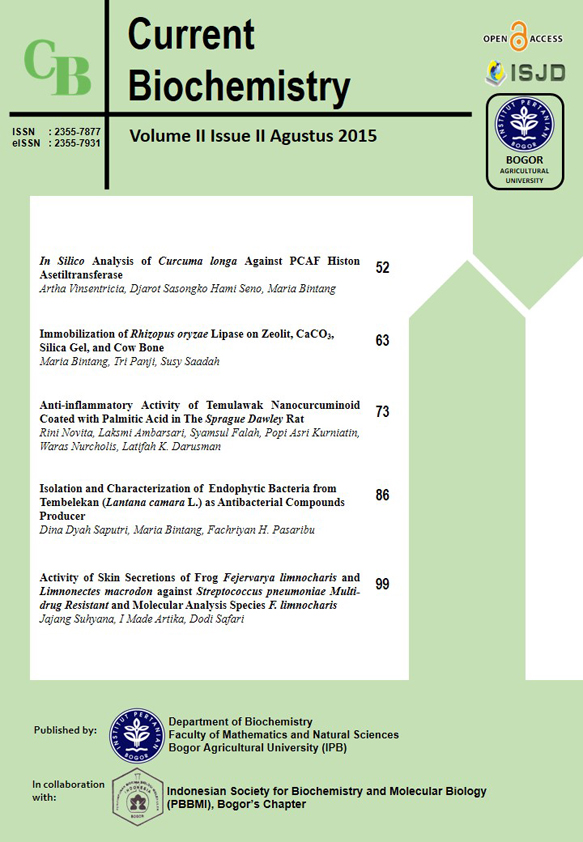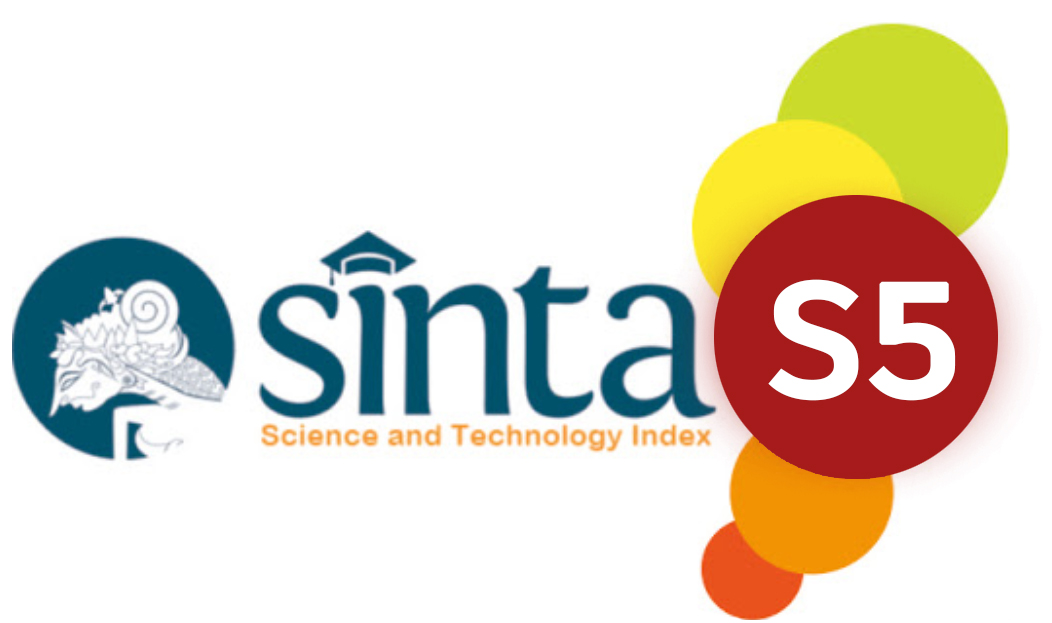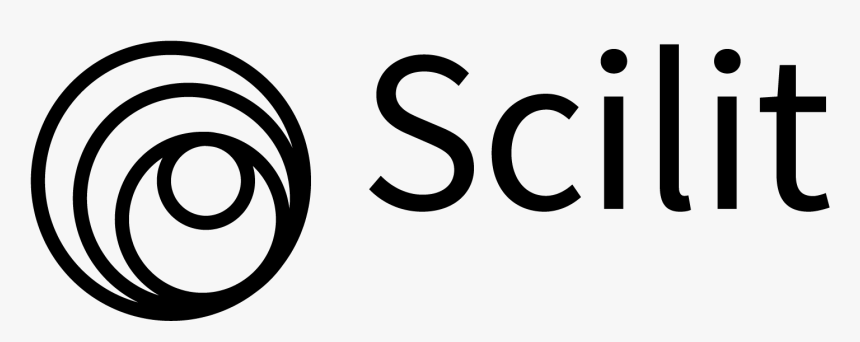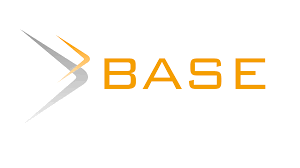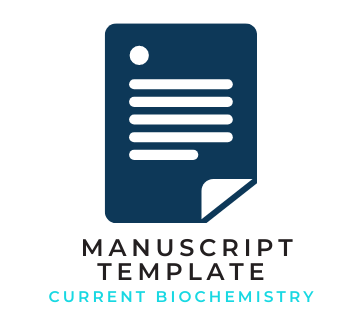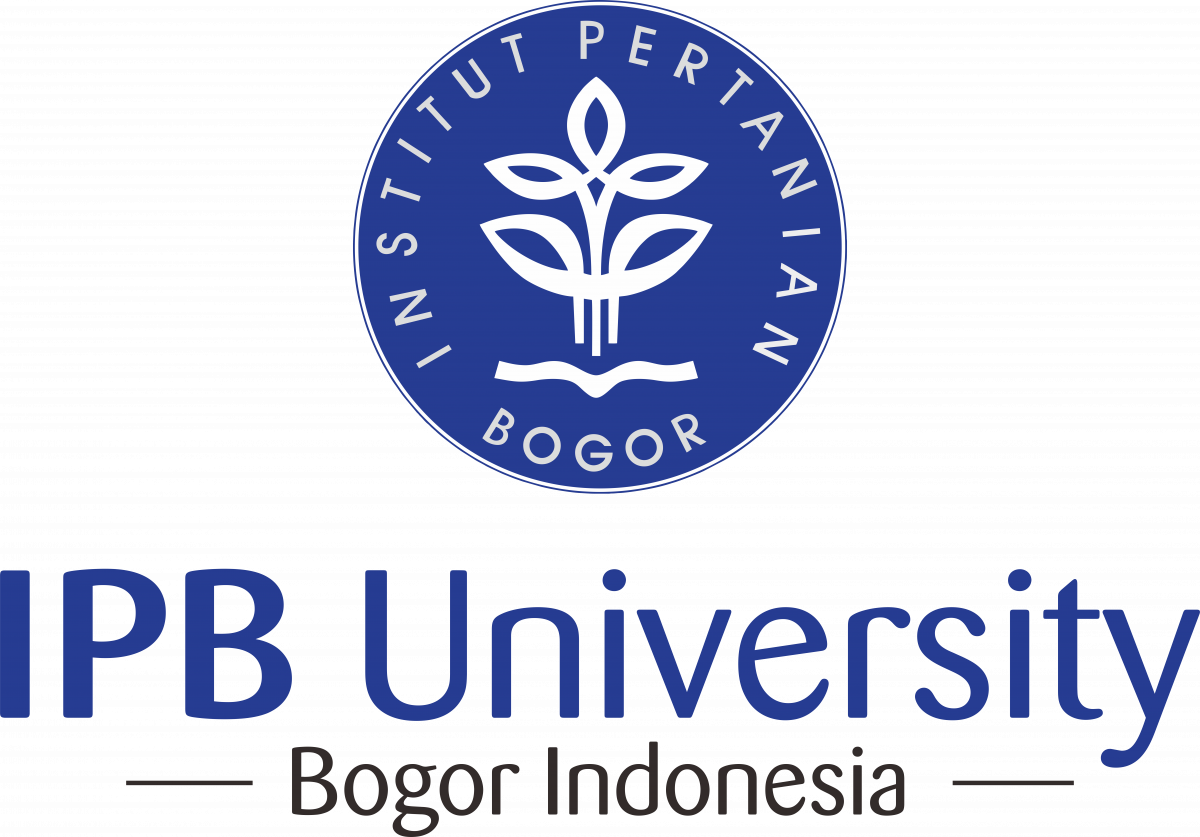<i>In Silico</i> Analysis of <i>Curcuma longa</i> Against PCAF Histon Asetiltransferase
Abstract
Curcumin turmeric (C. longa) has been found capable of inhibiting p300/CBP associated factor (PCAF) histone asetyltransferase (HAT) as a cancer biomarker. However, the molecular mechanism of inhibition is unkown. This study is aimed to analyse the molecular inhibition mechanisms by in silico method. The analysis showed that curcumin’s Gibbs free energy (ΔG) was stable and capable of binding amino acid residues believed to be active site of PCAF HAT. Curcumin is predicted to be a PCAF HAT inhibitor, and further in vitro analysis is required.
References
Arwansyah. 2014. Molecular docking simulation of curcumin and its analogs as selective androgen receptor modulators (SARMs) on prostate cancer[Thesis]. Bogor: Bogor Agricultural Univ.
Balasubramanyam K, Varier RA, Altaf M, Swaminathan V, Siddappa NB, Ranga U, Kundu TK. 2004. Curcumin, a novel p300/CREB-binding protein-spesific unhibitor of acetyltransferase, represses the acetylation of histone/nonhistone proteins and histone acetyltransferase-dependent chromatin transcription. J. Biol. Chem. 279: 51163-51171.
Bosco KH, Brasseur R. 2005. The Ramachandran plots of glycine and pre-proline. BMC Struc Bio. 5:1-14.
Clements A, Rojas JR, Trievel RC, Wang L, Berger SL, Marmostein R. 1999. Crystal structure of the histone asetyltransferase domain of human PCAF transcriptional regulator bound to coenzyme A. The EMBO J. 18(13): 3521-3532.
Dekker FJ, Ghizzoni M, Meer NVD, Wisastra R, Haisma HJ. 2009. Inhibition of the PCAF histone acetyl transferase and cell proliferation by isothiazolones. Bioorg Med Chem. DOI: 10.1016/j.bmc.2008.12.008.
Eliseeva ED, Valkov V, Jung M,Jung MO. 2007. Characterization of novel inhibitors of histone acetyltransferases. Molecular Cancer Therapeutics. 6:2391–2398.
Fan-qi Z, Shi-ming P, Li L, Li-bing M, Zhen-hua Z, Zhi-yuan Z, Niu H. 2013. Structure-based identification of drug-like inhibitors of p300 histone acetyltransferase. Acta Pharmaceutica Sinica. 48(5): 700-708.
Ghizzoni M, Boltjes A, Graaf CD, Haisma HJ, Dekker FJ. 2010. Improved inhibition of the histone acetyltransferase PCAF by an anacardicacid derivative. Bioorg Med Chem. 18: 5826-5834.
Gupta S, Kesarla R, Omri A. 2013. Formulation strategies to improve the bioavailability of poorly absorbed drugs with special emphasis on self-emulsifying systems. ISRN Pharmaceutics. DOI: http://dx.doi.org/10.1155/2013/848043.
Hodawadekar SC, Marmostein R. 2007. Chemistry of acetyl transfer by histone modifying enzymes: structure, mechanism and implications for effector design. Oncogene. 26:5528-5540.
Kim S, Kang H, Na H, Lee M. 2010. Trischosantin a enhances acetylation as well as protein stability of Erα through induction of p300 protein. Breast Cancer Research. 12:1-8.
Kumar R, Sanjuktha M, Singaravel R, Ramakrishnan S, Rajan JJS, Kumar S,Poornima M, Santiago TC, Alavandi SV. 2012. Molecular modelling and Docking studies on shrimp vitellogenin receptor and ligand target mediated delivery system. International J Research in Drug Delivery. 2(1): 11-14.
Leeson PD, Springthorpe B. 2007. The influence of drug-like concepts on decision-making in medicinal chemistry. Nature Reviews. 6:881-890. DOI: 10.1038/nrd2445.
Lipinski CA, Lombardo F, Segawa T,Ko D. 2001. Experimental and computational approaches to estimate solubility and permeability in drug discovey and development setting. Adv Drug Deliv Rev. 46: 3-26.
Mischak H, Delles C, Vlahou A, Vanholder R. 2015. Proteomic biomarkers in kidney disease: issues in development and implemention. Nature Reviews Nephrology. DOI: 10.1038/nrneph.2014.247.
Ott M, Verdin E. 2010. HAT trick: p300, small molecule, inhibitor. Previews: Chemistry and biology.
Sa G, Das T. 2008. Review: Anti cancer effects of curcumin: cycle of life and death. Cell Division. 3:14.
Salahshoor M R, Jalili C, Shebanizadeh D, Khazaei M, Roshankhah S, Ghorbani R. 2013. The apoptotic effects of the p300 activator on breast cancer and lung fibroblast cell lines. Middle East J Cancer. 4(4): 163-173.
Sterner DE, Berger SL. 2000. Acetylation of histones and transcription-related factors. Microbiology And Molecular Biology Reviews. 64(2): 435-459.
Stimson L, Rowlands MG, Newbatt YM, Smith NF, Raynaud FI, Rogers P, Bavetsias V, Gorsuch S, Jarman M, Bannister A.2005. Isothiazolones as inhibitors of PCAF and p300 histone acetyltransferase activity. Mol Cancer Ther. 4(10): 1521-1532. DOI: 10.1158/1535-7163.MCT-05-0135.
Zhang M, Wilkinson B. 2007. Drug discovery beyond the rule of five. Current Opinion in Biotechnology. 18:478–488. DOI: 10.1016/j.copbio.2007.10.005.

